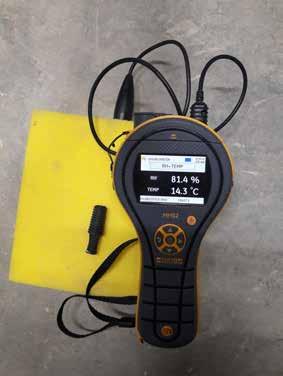
2 minute read
PREPARATION GUIDANCE
Subfloor/Substrate Types
The UltraFloor range of products are suitable for use on all subfloor/substrate types. These fall into two categories, porous and non-porous, the most common include:
POROUS
Concrete
Sand:Cement
Flooring Grade Plywood
Anhydrite
NON-POROUS
Epoxy Resin Damp Proof Membrane
Power Floated Concrete
Flooring Grade Asphalt
Porcelain, Ceramic, Quarry or Terrazzo Tiled Floors

Steel Mezzanine Decks
Access Panels
It is important to establish the type of floor you are laying onto so it can be prepared in the correct way. If you do not know then ask the question.
Subfloor/Substrate Preparation
The suitability of a subfloor/substrate should always be fully assessed before carrying out any preparation or installing a floor covering. British Standard 8204 should be referred to for full guidance and clarification.
The main criteria to be assessed is:
1. Sound/Solid - is the subfloor/substrate strong and stable?
2. Dry - has the subfloor/substrate dried/cured completely?
3. Free from Contamination - is the subfloor/substrate clean?
4. Laitance Free - is the subfloor/substrate surface free of fines?
If the answer to any of these is ‘no’, then the subfloor/substrate is not suitable to be laid onto and further preparation is required.
Testing for Moisture
Testing the moisture of a subfloor/substrate can be relatively straightforward, providing you know what you are assessing and have the appropriate equipment. British Standards are in place and subfloors/substrates should be tested in accordance with the British Codes of Practice BS 8203, BS 5325 and BS 8201. A BS hygrometer box should be used. This will provide a Relative Humidity (RH) reading. A reading above 75%RH is higher than is recommended to lay floors without a surface DPM.

> 75% RH
If a moisture reading taken is greater than 75%RH then the subfloor/substrate is considered wet (when laying textile/resilient floor coverings, 65%RH for wood). Provided the subfloor/ substrate is suitable to receive moisture protection products either a DPM or a MVS can be used. If using either UltraFloor DPM IT or UltraFloor Suppress IT, follow the product’s respective usage instructions as detailed on the datasheet.
OF COMPLAINTS ARE AS A RESULT OF MOISTURE
Source: FITA
If a subfloor/substrate has not reached the required level of dryness before a floor covering is laid then residual moisture held between the aggregate and cement (or other binder) will slowly be released, reaching the subfloor/substrate preparation and the floor covering causing damage from beneath.
Only as a two coat application, UltraFloor DPM IT may be used on subfloors/substrates where there is an absence of a constructional base DPM provided there is no hydrostatic pressure. UltraFloor DPM IT should not be used in projects where hydrostatic pressure is a concern. In such cases the use of pressure relief drainage and/or external tanking systems must be the primary method of protection against moisture.
How to remove Contamination and Laitance?
Following British Standard 8204 all subfloors/substrates must be free from contaminants that may prevent adhesion such as dust, oils, grease, surface laitance, water soluble adhesive residues and weak smoothing underlayments etc.
Various methods and machines exist which are designed for the preparation, removal and finishing of subfloors/substrates prior to the application of any UltraFloor product. They include STGs, Shotblasters, Planers, Grinders, Multi-strippers and Dust Extractors.
We recommend that you contact The Preparation Group for advice on the appropriate method/s for your job and for equipment hire www.thepreparationgroup.com.
Smooth dense surfaces can be roughened by mechanical scabbling to enhance the key.
Priming
Why should you prime?
Priming of subfloors/substrates is key to ensuring the selected smoothing underlayment can perform to its optimum. It improves the flow and workability of the smoothing underlayment. There are three basic reasons why priming is important.
Firstly, priming reduces the absorbency of the floor; secondly it increases adhesion and finally, correct priming acts as an interface between materials preventing failure by reaction. The simple process of using the appropriate primer will minimise issues and result in:
Smoother Underlayment Stronger Underlayment Reduced Labour Time A surface fit to lay the thinnest of decorative floor coverings to


